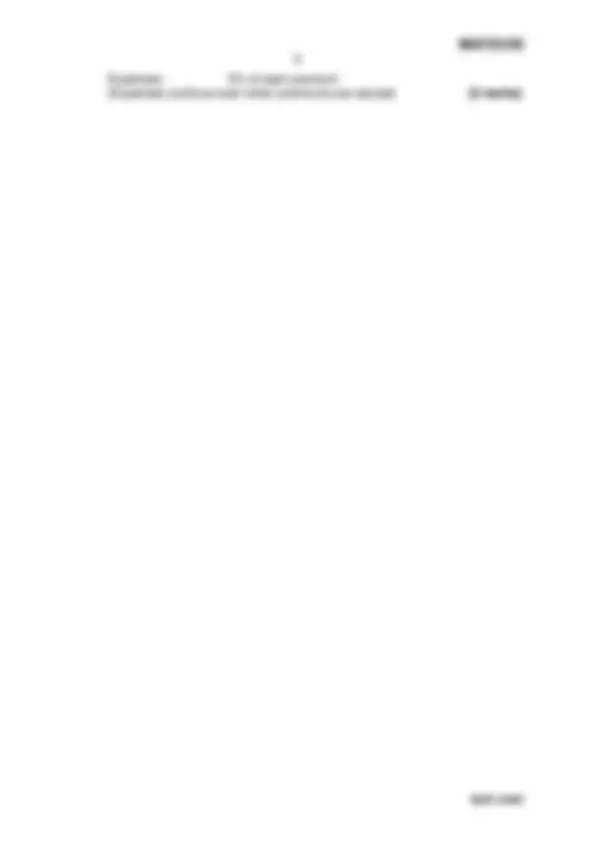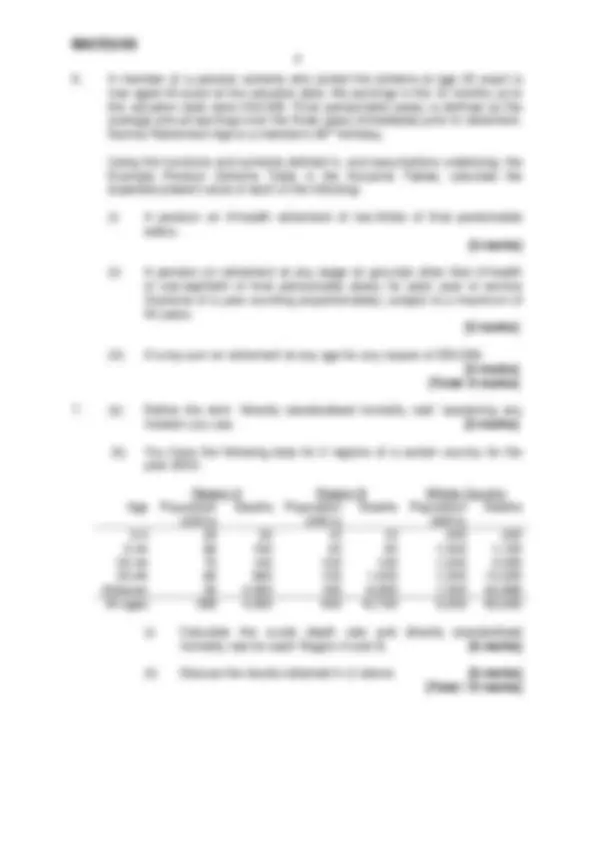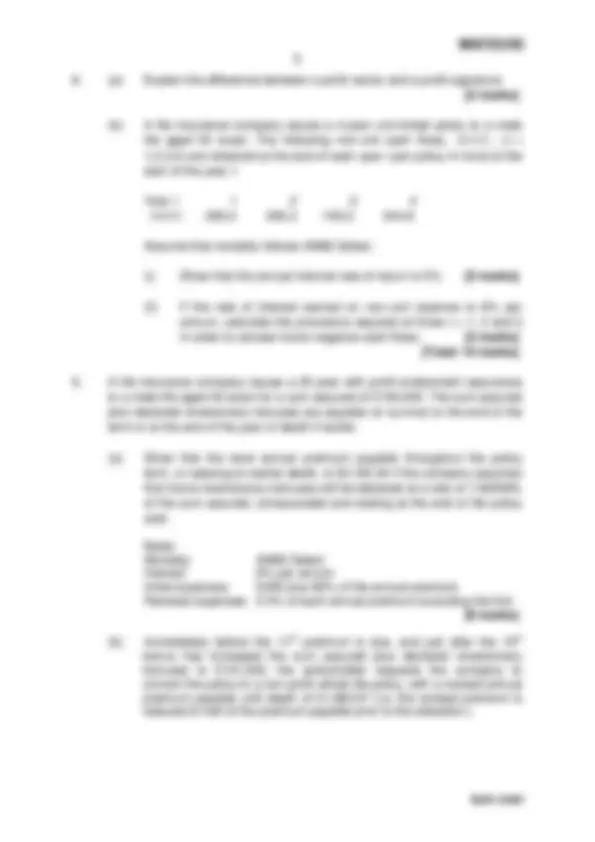





Study with the several resources on Docsity

Earn points by helping other students or get them with a premium plan


Prepare for your exams
Study with the several resources on Docsity

Earn points to download
Earn points by helping other students or get them with a premium plan
Community
Ask the community for help and clear up your study doubts
Discover the best universities in your country according to Docsity users
Free resources
Download our free guides on studying techniques, anxiety management strategies, and thesis advice from Docsity tutors
Professor Malcolm Brown, University of Kent, Statistics and Economics, Actuarial Mathematics I, Exam 2005, FACULTY OF SCIENCE, TECHNOLOGY AND MEDICAL STUDIES, reversionary bonus, directly standardised mortality rate, AM92 Ultimate mortality, risk discount rate, GRADUATE DIPLOMA IN ACTUARIAL SCIENCE, GRADUATE CERTIFICATE IN ACTUARIAL SCIENCE.
Typology: Exams
1 / 7

This page cannot be seen from the preview
Don't miss anything!




turn over
Friday, 6 May 2005 : 09.30 – 12.
This paper contains TEN questions. Answer ALL questions. The marks allotted are shown at the end of each question.
Copies of Formulae and Tables for Actuarial Examinations are provided. Approved calculators may be used.
Using the above, determine the value of the following
(i) (^) n q (^) xy [2 marks] (ii) (^) n qxy [2 marks]
(iii) A (^) xx^2 [2 marks]
(b) Express fully in words what the symbol (^) n q (^) xy^2 means. [2 marks]
[Total: 8 marks]
Calculate the monthly premium ignoring expenses and margins.
Basis: Mortality: PMA92C20/ PFA92C20. Interest: 4% per annum interest. [7 marks]
£100 per week for the first two years of sickness, reducing to £50 per week thereafter during sickness. Sickness benefit ceases at age 65, or on earlier recovery or death. There is no waiting or deferred period.
Level premiums under the policy are payable weekly in advance until age 65 or until earlier death. Any premiums falling due during periods of sickness are waived.
Calculate the weekly premium.
Basis: Mortality: ELT15 (Males) Sickness Table: S(ID) in the Actuarial Tables Interest: 6% per annum
Using the functions and symbols defined in, and assumptions underlying, the Example Pension Scheme Table in the Actuarial Tables, calculate the expected present value of each of the following:
(i) A pension on ill-health retirement of two-thirds of final pensionable salary. [3 marks]
(ii) A pension on retirement at any stage on grounds other than ill-health of one-eightieth of final pensionable salary for each year of service (fractions of a year counting proportionately), subject to a maximum of 40 years. [3 marks]
(iii) A lump sum on retirement at any age for any reason of £50,000. [3 marks] [Total: 9 marks]
(b) You have the following data for 2 regions of a certain country for the year 2003:
Region A Region B Whole Country Age Population (000’s)
Deaths Population (000’s)
Deaths Population (000’s)
Deaths
0-4 20 30 10 10 200 220 5-24 80 100 50 50 1,000 1, 25-44 70 140 100 150 1,200 2, 45-64 60 800 150 1,500 1,300 14, 65&over 50 2,930 190 8,990 1,300 62, All ages 280 4,000 500 10,700 5,000 80,
(i) Calculate the crude death rate and directly standardised mortality rate for each Region A and B. [6 marks]
(ii) Discuss the results obtained in (i) above. [6 marks] [Total: 15 marks]
turn over
(b) A life insurance company issues a 4-year unit-linked policy to a male life aged 50 exact. The following non-unit cash flows, NUCFt , ( t = 1,2,3,4) are obtained at the end of each year t per policy in force at the start of the year t:
Year t 1 2 3 4 NUCF t -350.2 200.2 -150.2 344.
Assume that mortality follows AM92 Select.
(i) Show that the annual internal rate of return is 5%. [5 marks]
(ii) If the rate of interest earned on non-unit reserves is 6% per annum, calculate the provisions required at times t = 1, 2 and 3 in order to zeroise future negative cash flows. [3 marks] [Total: 10 marks]
(a) Show that the level annual premium payable throughout the policy term, or ceasing on earlier death, is £3,165.34 if the company assumes that future reversionary bonuses will be declared at a rate of 1.92308% of the sum assured, compounded and vesting at the end of the policy year.
Basis: Mortality: AM92 Select Interest: 6% per annum Initial expenses: £400 plus 60% of the annual premium Renewal expenses: 2.5% of each annual premium excluding the first [8 marks]
(b) Immediately before the 11th^ premium is due, and just after the 10th bonus has increased the sum assured plus declared reversionary bonuses to £121,000, the policyholder requests the company to convert the policy to a non-profit whole life policy, with a revised annual premium payable until death of £1,582.67 (i.e. the revised premium is reduced to half of the premium payable prior to the alteration.)
Calculate the revised sum assured.
Basis Mortality: AM92 Ultimate Interest: 6% per annum Alteration expense: £ Renewal expenses: 2.5% of all future annual premiums [7 marks]
(c) State one other consideration that the company should take into account before completing the alteration in (b) and explain why they should do this. [2 marks] [Total: 17 marks]
The company sets premiums so that the net present value of the profit on the contract is 5% of the annual premium and uses the following assumptions in its profit test of this contract:
Rate of interest earned on funds: 5% per annum Mortality: AM92 Select Withdrawals: None Initial expenses: £ Renewal expenses (on the second and subsequent premium dates): £50 per annum plus 2.5 % of the premium
In addition, the company holds net premium provisions, using AM92 Ultimate mortality and interest of 4% per annum.
(a) Using a risk discount rate of 8% per annum, calculate the premium. [16 marks] (b) Without carrying out any further calculations, state with brief reasons what the effect on the premium would be in each of the following cases:
(i) The company uses a risk discount rate of 10% per annum
(ii) Mortality is assumed to be AM92 Ultimate [4 marks] [Total: 20 marks]